Related Content
Content
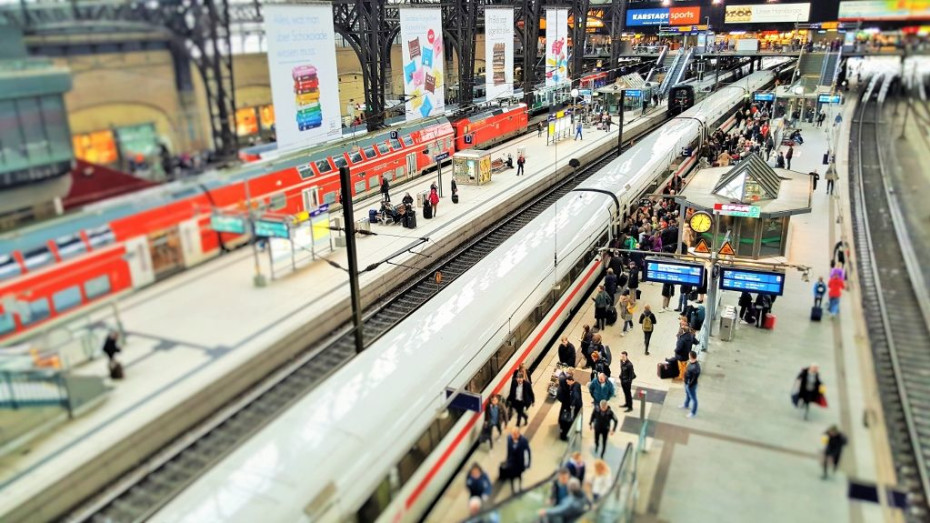
24 Tips For Stress Free European Train Travel
How to travel around Europe by train, including tips for using the trains and stations, managing luggage and making the most of the journeys
Share
Introduction
These European train journey tips are packed with insights into the less obvious aspects of European train travel - most of them only became apparent to us on our extensive travels in recent years.
So grab a coffee and spend 10mins ish absorbing all the info below, or click on a specific topic of interest from Content menu - they will help you make the most of exploring Europe by train!
Or if you'll be embarking on a rail pass itinerary we've got some specific tips for you:
When you're on your trip AND when you're planning it.
And we've also explained the language you can encounter when traveling in Europe by train.
1. Be aware when using ticket and journey planning apps:
Online ticket agents and apps will assume that European trains will always run on time AND that you'll want to reach your destination in the fastest possible time.
Hence when looking up journeys with changes of train, you’ll frequently be shown options with connecting times between trains of less than 15 mins.
But, avoid thinking ‘great, I won’t have to hang around too long at a station’ because more often than not, these ‘connections’ between trains aren’t guaranteed - European trains aren't exceptionally punctual.
If the first train is delayed, the second train you are connecting to may not wait until the first train has arrived.
Hence our preference is to choose routings with a connecting time between trains of at least 30 mins – or to be pro-active and extend the connecting times between trains, when a website or app offers the ability to do that.
Having to buy new tickets in the event of a missed connections is the exception rather than the rule, but the hassle of having to get tickets or reservations re-issued is best avoided.
So the fastest journey may not be the optimum journey - have a lunch in or near the station, or deposit your bags in the left luggage and explore the location where you'll be changing trains.
Though this isn’t something you need to keep in mind when travelling within Switzerland and The Netherlands by train.
In those countries tightly timed connections are a feature of the timetable and the timings can be relied upon.
2. Avoid relying on the final train of the day:
If you’ll be travelling a long distance route that includes connections, then avoid having to connect into the final train of the day to your destination.
The train you'll be relying on to take you to where you’ll be spending the night, may not wait if your ‘connecting’ train has been delayed.
So when planning a trip, if you're offered a choice of options for your end-to-end journey, select one of the options which sets off sooner than the last routing of the day.
If you're only offered one option, check to see if you can actually set off earlier from your start point; look up separate tickets for each leg of your journey if need be.
Do that and you might be able give yourself a couple of hours to make that subsequent connection.
In this particular scenario, you'll probably need to buy separate tickets for each train you'll be taking, which will likely be more expensive, but you'll be minimising the risk of missing that vital train on to a final destination.
3. 1st class can be cheaper than 2nd class:
On journeys where advance discounted tickets are available, the cheapest types of ticket may still be available for 1st/Premier class tickets, but sold out for travel in 2nd class.
If that is the case, you can book for 1st class and save, because the 1st class tickets will be the cheapest tickets still on sale; though it's not a common scenario, so you'll need to have luck on your side.
However, be generally open to the possibility of travelling in First Class, always check the price and don't assume it will always be much more expensive.
If there’s only a €5-10 difference in the price and the First Class offering includes complimentary food and drink, travelling in First can be a better deal than travelling in Second.
4. Avoid busy times:

When in holiday mode it can be easy to forget that less fortunate souls are still having to commute into work or travel on business.
So if you’ll be taking trains which DON'T have to be reserved, try to avoid travelling into big cities between 08:00 and 10:00 - or taking trains from them between 17:00 and 18:30.
Times of high demand also push up prices, partially because the cheaper tickets inevitably sell out faster at times when most people want to travel, but also because the cheaper ticket prices for long-distance journeys may not be available at all at business hours.
If you’re going to be travelling long distance it can be a good idea to avoid 12:00 – 19:00 on Fridays, between 14:00 and 19:00 on Sundays - and in the summer avoid Saturdays between 08:00 and 15:00 – particularly on routes to holiday resorts.
If you will be travelling at these times, book as far in advance as you can, if you also want to track down a good deal.
5. Look up departure times on the ticket websites / apps:
If you're planning to buy tickets last minute at the station, it still can be a good idea to look up the train times before heading off.
Gaps of more than 90 mins between trains are fairly common on popular, busy routes in continental Europe.
Many popular local and regional daytime trains, which are ideal for taking day trips, also don't operate to regular timetables - particularly in France, Italy and Spain.
Usually the easiest means of finding out the train times online, is to look up the journey on the ticket booking websites - as if you would be buying tickets online
You'll find the websites and apps you can use to look up the trains on our ticket guides.
6. Try not to go long distance on weekends or holidays:
Railway lines need maintaining and more often than not this work is carried out on weekends or over holidays.
On continental Europe trains still tend to run, but they can be heavily delayed, miss out station calls, or use alternative stations – but in Britain the trains tend to be replaced by buses.
So try to arrange an itinerary so that you’ll be travelling long distance on Mondays to Fridays.
When alterations have been made to the usual timetable, the new alternative information at stations and on the trains often wont' be available in English, and apps may not have any last minute changes.
Therefore it’s easy to be tripped up when the usual schedules have been altered – our journey info may also not be wholly accurate in those circumstances.
7. Reserve for long distance journeys when you don’t have to:
Joy of joys, you’ll be travelling on an express train that doesn’t have to be reserved, so bothering to do so can seem like an expense that can be avoided and an un-necessary hassle.
However, be wary, especially if you’ll be travelling 2nd class - you can board a long distance train and find that no seats are available at all.
The rules that ShowMeTheJourney follows on our travels is to make optional reservations, if TWO or more of these criteria apply:
- the journey is longer than 90 minutes
- the frequency of train service is 1 x train every OTHER hour, or less
- will be joining a train at an intermediate station
- will be boarding at any station between
- 08:30 and 10:30 on Mon– Sat
- 16:30 and 18:30 on Mon- Thurs
- 12:30 and 19:30 on Friday
- 08:00 and 12:00 on summer Saturdays
- 14:30 and 19:30 on Sundays
Also watch out for national holidays, the trains will be particularly busy on the days either side.
8. Take the opportunity to select your seats:
If you will be booking tickets online, for certain trains on which seat reservations are available or included when booking tickets, you will often be given an option to select the ambience in which you wish to travel by.
This facility is available when booking tickets for any journey by Frecce and TGV trains, when booking reservations on ICE trains and on many other services.
The options always include whether you wish to travel in a window or an aisle seat, but can also include the ability to select seats in compartments, or at tables etc.
When making a booking you MAY also see a link to a seating plan.
These seating plans aren't usually integral to the booking path, meaning that you don't have to use them to book a ticket, so in the rush to make a booking they can be easily missed.
Our advice is to make the most of them, when they're available, as the location of your specific seat can have a big impact on the quality of a journey, for these FIVE reasons;
(1) Choosing forward facing seats.
This facility is available when booking departures by these trains online:
TGV Atlantique,
TGV Sud-Est
TGV France-Italy
ICE 1
ICE 4
Plus:
- Regiontog trains on the Oslo - Bergen route,
- Snabbtåg services in Sweden by the X2000 and SJ 3000 trains a
- some TGV-Lyria departures
- on all trains operated by Czech national rail operator, CD, that can be booked online.
However, this ability to choose forward facing seats is not universal, for example, it's not available on departures by Frecce and TGV Duplex trains, or the other types of ICE trains.
(2) You can select seats near the exit doors, particularly useful if you've got heavy luggage, as you can then avoid having to manoeuvre it into the middle of the train.
These seats also tend to be nearer any luggage racks, so you'll be able to keep an eye on your bags more easily.
(3) If you will be making a tightly timed connection, that can be another good reason for choosing a seat by the doors, but if you want to have a quieter trip you'll be better off choosing a seat in the middle of the coach.
(4) You can choose between table seats and airline style seating.
Don't choose a table seat on the assumption that you will have more leg room, if somebody tall takes the seat opposite yours, then you'll actually have less.
Targeting table seats is obviously a good option if you are travelling in a group of three or four, but when we're not, we prefer the greater privacy of the airline style seats.
And if you are planning to eat on the train, then the airline seats have a pull down tray.
(5) A plus of table seats, is that they nearly always line up with the windows, but a surprisingly high number of the 'airline' seats won't.
The more modern the train you will be travelling by, the greater the chance that you won't have a good view out of the window, in both 1st and 2nd class.
9, Don’t rush into buying the cheapest tickets:
So you’ve found a ticket at the cheapest possible price = Result!
However, when booking proceed with caution and check the timings of the train that the ticket is valid for.
Will you feel so satisfied with grabbing a bargain when your alarm wakes you at 6am?
Also double-check the journey times, tickets for another train may be more expensive, but that’s because it’s twice as fast.
The cheapest advance tickets can also rarely be exchanged or refunded if you subsequently need to change your travel plans for any reason, so they can be a false economy.
10. Allow extra time to reach a station;
So you’ve used our station guides and you have the transfer from where you'll be staying to the station worked out.
You know how long it will take to get there, and you might already have a ticket with a reserved seat, so you can relax and breakfast at your leisure.
But, that time you’ve set aside to reach the station and then find your train? Double it.
I’ve found myself running for trains because I’ve been stuck in a tram jam, travelled the wrong way on a metro, spent 20 minutes trying to pay for a coffee etc etc.
11, Use the train numbers:
This is something that can particularly trip up British travellers as train numbers aren’t used in Britain, but they are in most other European countries (they’re not for non-international trains in Belgium, Denmark, Norway, The Netherlands and Switzerland).
Each specific train departure can be given a unique number, which is used on train-specific tickets AND on the departure information at stations – this is the case in Austria, Germany, France, Italy, Spain, Sweden and Eastern Europe.
So find this number on your ticket, it’s different to the departure time, and then look for this ‘train number’ on the departure boards.
The electronic departure info at stations will include the final destination of a train, but usually only some of the other stations it will be calling at will be listed.
Therefore you might not see the station you’re heading to on these departure screens, large and small, so instead look for the train number.
A matching train number means that you’ve found the train you need to take.
12. Make Use of Information Desks:
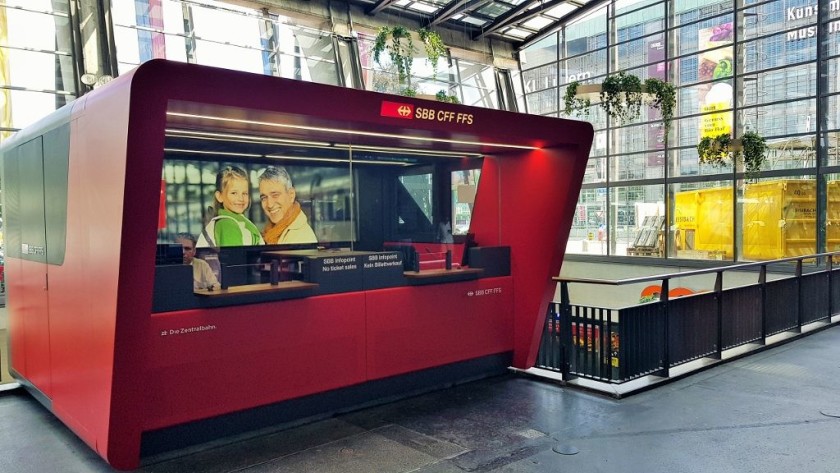
Despite ShowMeTheJourney's best efforts to simplify things, you’ve probably gleaned by now, that travelling by train around Europe can involve some minor complications.
Hence virtually all major stations across the continent have information desks, where asking questions won’t cost you anything and can save time and money.
At all major stations, the info desk staff will speak English and that also usually applies in other locations popular with tourists.
13. Stay somewhere on a metro line:
Finding a place to stay within a 10 min walk of a major station can be a problem for three reasons:
(1) major stations can be on the edge of city centres, so can be some distance from the locations of the highest number of hotels and hostels.
(2) a station may not be in the most desirable parts of town - and
(3) the combination of a quality hotel AND being adjacent to a station often pushes up prices.
So a good alternative is to look for places to stay with direct public transport connections from/to the city’s main station – particularly if you can find somewhere right by a metro or local train station.
The 10-20 mins you spend on a metro/tram/local train to access the hotel may not take any longer than walking from the station to a city centre - plus you could make big savings and the hotel/hostel may be easier to find.
We’ve also learned that walking through city streets near stations after dark, with your phone in your hand so that you can follow a map app, isn’t always something you’ll feel comfortable doing.
Having a wide choice of quality accommodation at reasonable prices, right by a station is rarer than you might assume, but these stations do meet that criteria – Bologna Centrale, Frankfurt (Main) Hbf, Malmo C, Milano Centrale, Munchen Hbf, Roma Termini and Wien Hbf.
This is an edited highlight of ShowMeTheJourney's guide to booking accommodation when travelling by train.
14. Plan ahead for how to find your final destination:
The benefits of booking that great place to stay, only 10 mins walk from the station, can soon be negated if you then struggle to find it.
That location app won’t be much use if your phone is about to power down, or if you can’t get online.
So before you embark on a journey that will climax at a hotel or hostel, make a simple note of the route from the station to where you will be staying.
In particular note the name of the first street, by the station, that you’ll be using in order to reach your accommodation.
The name of this street will very likely be on the exit signs at the station – and leaving by the right exit can avoid being swamped by confusion.
We also use Google Maps when we're working out the route, to see if there is a landmark adjacent to where we’ll be staying – is it beside a pharmacy etc.
15. Take food / drink on to the train:
The food and drinks available on European express trains tend to over-priced and uninspired (though the food on Swedish and German trains is better than average – and on Austrian Railjets it's excellent).
It also might not be available at all, I once endured an 8 hour journey with no breakfast and lunch as the bar counter was closed for the entire trip!
Great food can always be picked up from inside major stations in Germany, Austria and Denmark - and British station food is better than average.
However, in other countries this can be inconsistent, often a better option is picking up something from a shop or bakery by the station.
16. Two medium sized bags is better than one large bag:
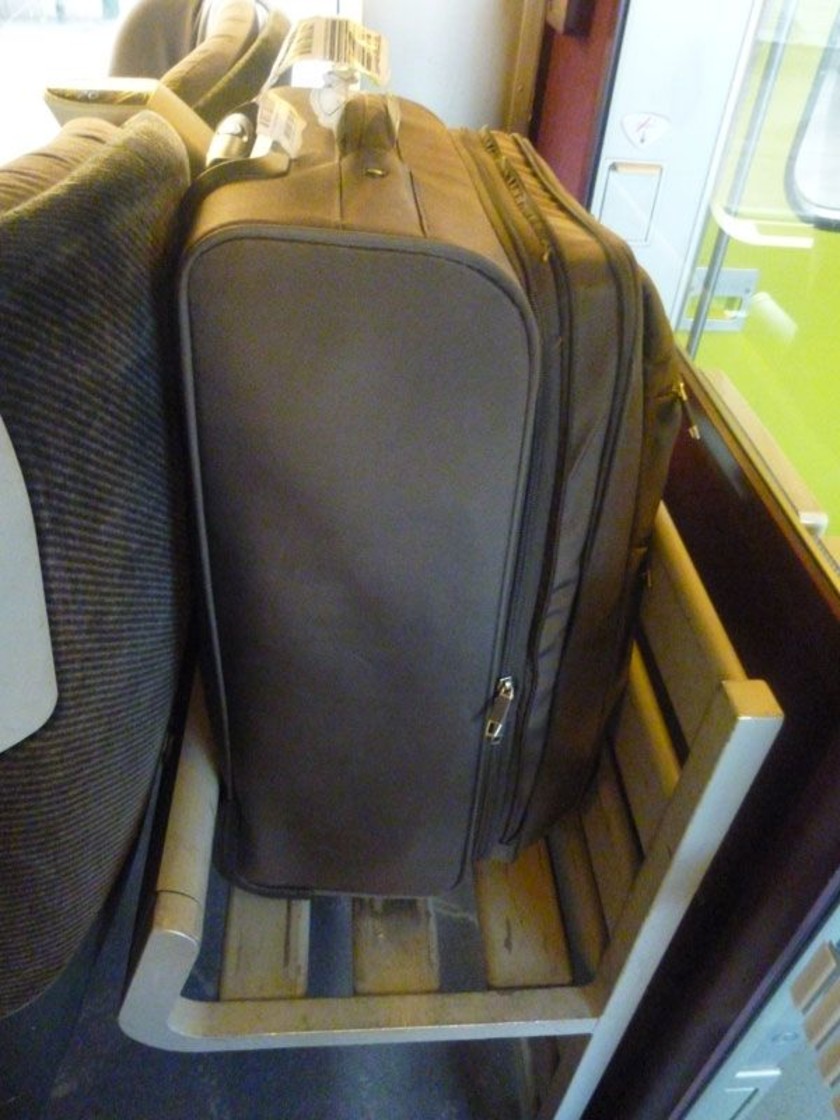
On European express trains luggage storage areas that aren't above head height, are the exception rather than the norm.
When luggage racks are provided, the larger sized bags may not fit in them and they may not fit in the luggage spaces above, or between the seats either.
Also be aware that on many trains, the only luggage storage option will be on the overhead racks above the seats, so being able to lift your bag(s) above your head, will be a plus.
So if you divide your luggage, not only will each bag be lighter, you'll also have more storage options.
Note how this mid-sized bag pictured above is a good fit for this luggage rack on a TGV train.
17. Stow your luggage and then find your seat:
If you’ll be travelling with luggage it can seem logical to find a seat first and then consider where to put your bags – even if you have a seat reservation.
Instead when boarding a train, make the stowing of your luggage a priority – our rule is ‘never walk passed a luggage rack if there’s space to store bags on it’.
If you don’t, then when having found your seat, you can discover that there’s nowhere around it in which to stow your bags.
You may realise that you want to use the luggage rack by the door after all, but now there will be a line of people between you and it.
So as you board with your bags take your time and prioritise where to put them, they might also fit between the seats or under them.
Often there won’t be enough space for everyone’s large bags – so being a tad selfish can make for a more comfortable journey.
Also if you’ll be using a back-pack, take it off before you’re on the train.
18. Don’t miss out on great views:
On the majority of Europe’s most scenic railway routes, the passengers on one side of the train will be looking out over the sea, mountains or rivers, while those on the other side of the train are seeing nothing special at all.
So if you find that your reserved seat is on the wrong side of the train, temporarily move seats and don’t miss out.
Though if the train conductor appears, jump back to the seat you’re supposed to be sat in.
19. Know the local name of your destination:
Unsurprisingly when travelling in Europe, the local population don’t use the English or names in other languages, which have been given to their cities.
So avoid thinking ‘I can see a train to Firenze, but I’m heading to Florence so I don’t know what to do?’ Firenze is Florence etc etc etc.
An additional layer of confusion can set in when taking any international train, because at the station where you'll be commencing your journey, the local language name will often be used for an international destination.
For example if you will be taking a train from Sweden to Copenhagen you need to look for Kopenhamn on the departure indicators, Kopenhamn is the Swedish name for Kobenhavn.
Other place names that can cause confusion include:
Anvers = Antwerp
Gand = Gent
Koln and Koeln = Cologne
Luik = Liege
Marsiglia = Marseille
Venedig = Venice
Wien = Vienna
Also many towns and cities have more than one station, so be aware of at which exact station, you’ll need to leave your train.
Avoid seeing the name of the city you’re travelling to on a sign and assuming you need to leave the train at that station, or hearing the name of the city within an on board announcement and then rushing off the train in error.
20. Manage expectations of 1st class:
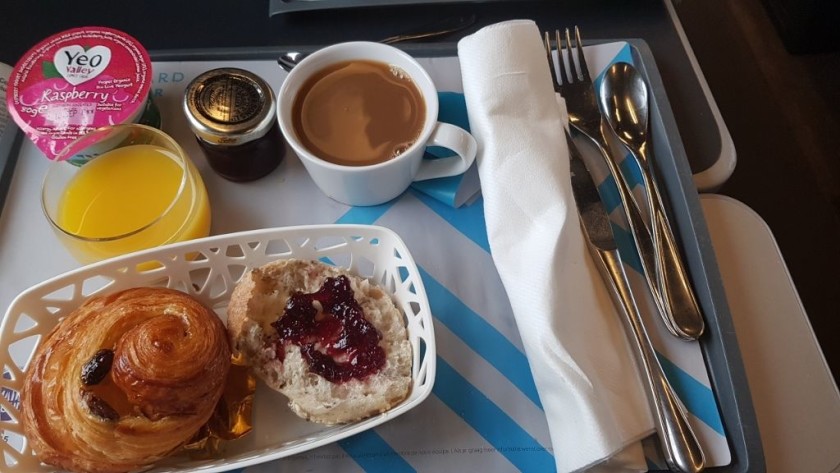
What we’re not referring to is the seat you will be sitting in, if you’ll be travelling 1st class or its equivalent.
Though worth keeping in mind, is that if you’re first impressions are disappointing - be assured that your seat and leg room will usually be larger and therefore more comfortable than that in 2nd class.
Instead what we are drawing your attention to is the discrepancies in the on-board service, which 1st class travellers receive on European express trains – in other words what is and isn’t included with your ordinary 1st class ticket.
You might be given complimentary light meals, or only drinks/snacks, or nothing at all.
Hence this non-comprehensive summary:
(Complimentary light meal (included in the price of the ticket)
International trains:
Eurostar (e300) and Eurostar (e320) and Lyria and Thalys*
*On Thalys trains the meal is only served in 'Executive Class'.
Great Britain:
Azuma (operated by LNER); Intercity Express (operated by Great Western); Intercity 225 (operated by LNER); Pendolino trains and Super Voyager trains (operated by Avanti West Coast); InterCity 125 trains and Voyager trains operated by CrossCountry)
Czechia:
on SuperCity trains
Poland:
on EIP trains
Spanish trains (not available on Saturdays):
Alvia 103/703 and AVE (100) and AVE (102/112) and AVE (103) and Euromed
Swedish trains (breakfast only):
SJ 3000 and X2000
Complimentary drink/snack (included in the price of the ticket):
British trains:
Adelante (operated by Grand Central) and Turbostar trains (operated by CrossCountry) and Long-distance trains operated by East Midlands/EMT trains
Czech trains:
Regiojet and Leo Express
Italian trains:
All Frecce trains and Italo trains
Scandinavian trains:
IC Denmark and Lyn and Regiontog and SJ 3000 and X2000
International trains:
Berlin - Warsaw Express l Thalys
A complimentary hot/cold drink is also served to 'Premiere Pro' ticket holders on TGV trains.
At Seat Catering Service:
On these trains the catering isn't complimentary, but catering staff will pass through the 1st class coaches and you can order food/drink to be delivered to your seat.
Austrian trains: Railjets
Czech trains: Railjets
German trains: All ICE trains
International trains: DB-SNCF (TGVs and ICEs).
21. Pay attention to on board announcements:
In many European countries announcements at stations and on trains are usually delivered in the native language and English (France is a notable exception - announcements on non-international trains are only made in French).
However, when there is a change to the usual train operations to do with a delay, or a diversion, or a train formation etc– English translations often aren’t provided.
It can be easy to lapse into listening out for the announcements in English and to ignore everything else, but take care not to tune out.
Because that non-English info is usually something you will need to be aware of, don’t be embarrassed and ask your fellow travellers if someone can translate it for you.
22. Avoid following the crowd:
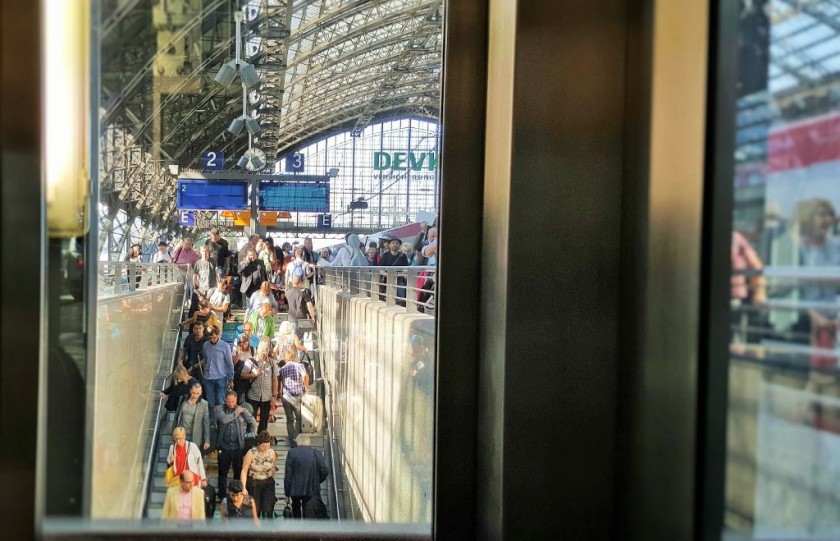
ShowMeTheJourney has observed that travellers often adopt a somewhat illogical group mentality.
If one traveller gets up from their seat and moves to stand by the door of a train, it can trigger most of our fellow travellers into doing the same - I've done this myself.
However, that initial traveller may have a tightly timed connection into another train, but if you don’t, it won’t matter if you’re the last person to leave the train.
In other words, take your time, if there’s no need to rush.
The ‘this train is about to arrive at…’ announcements are just telling you and everybody else the next station stop, they’re not a call to action to join a stampede.
These announcements can be made 10 mins before the train will actually arrive, but if you don't have a complicated set of luggage to collect on your way to the train doors, it's usually better to leave your seat as a train is pulling into a station..
That's because if a train is delayed, it's most likely to occur, just before it arrives at a station - so if you’ve left your seat to join the queue by the doors, you can be stuck in that queue for a while.
Also resist the temptation to follow the crowd when you step off of the train, most of your fellow travellers will be regular users of the station, but you won’t be.
They won’t have luggage, so don’t need to use alternatives to the stairs, and probably won’t need a taxi, or the bus you need to take – so it's likely they won’t be heading in the direction you need to follow.
So take your time to work out your easiest option for exiting a station, for example, lifts/elevators may be available, but not particularly visible.
23. Take care to know the 'rules':
Different rules and quirks apply to train travel in every European country, so avoid assuming that taking the train is the same to how you’re used to at home, or that the same rules apply as the previous country you have just travelled through.
You may now need to stamp tickets to validate them, make reservations, look for a weekend timetable etc, when you didn’t have to do any of these things in the previous country, or don’t have to do those things at home.
Also remember where you are - if you're following an itinerary through 'border-less' Schengen countries, it can be easy to forget that you've actually arrived in a different country.
Knowing the rules matters because if you’re challenged by a train conductor because you don’t have a reservation or the right ticket, it’s likely that you won’t be able to claim immunity because you’re a tourist.
The train conductors have heard too many excuses from unscrupulous travellers.
Also never think ‘I won’t bother with that compulsory reservation, what’s the worst that can happen? ’etc.
The least worst scenario is that it’s likely that you will end paying more than you would have, if you had obeyed the rules.
24. Avoid making generalisations:
As there are such wide variations in European train services, try to avoid making generalisations.
Just because you were disappointed by the amount of leg room you had in 1st class on one particular train, it doesn’t mean that 1st class isn’t ever worth the price difference.
If you were delayed twice in Demark, it doesn’t mean that Danish trains don’t run on time - Danish trains are actually comparatively punctual.
Also be wary of sweeping negative generalisations that you can find online, just because a blogger worked out that a Eurail pass didn’t make savings on an itinerary, it doesn’t follow that you won’t save with a Eurail pass etc.
And if you have read an article featuring 24 European train travel tips, it doesn't mean that travelling by train in Europe is particularly complicated.
Simple direct train journeys from A to B are usually easy and often fabulous!
Please support ShowMeTheJourney
This second version of ShowMeTheJourney is exciting and new, so we are genuinely thrilled that you are here and reading this, but we also need your help.
We’re striving not to let anything get in the way of providing the most useful service possible, hence a facility has been set up with DonorBox which can be used to support the running costs and make improvements.
Instead of advertising or paywalls, your financial support will make a positive difference to delivering an enhanced service, as there’s a lot of ideas which we want to make happen.
So if you have found the info provided here to be useful, please go here to say thank you.
Look for a journey guide

Simon Harper
I wanted to share my passion for train travel and explain how anyone can take the fantastic journeys I have taken.

This is one of more than 100 train travel guides available on ShowMeTheJourney, which will make it easier to take the train journeys you want or need to make. As always, all images were captured on trips taken by ShowMeTheJourney.
This second version of ShowMeTheJourney is exciting and new, so we are genuinely thrilled that you are here and reading this, but we also need your help.
We’re striving not to let anything get in the way of providing the most useful service possible, hence a facility has been set up with DonorBox which can be used to support the running costs and make improvements.
Instead of advertising or paywalls, your financial support will make a positive difference to delivering an enhanced service, as there’s a lot of ideas which we want to make happen.
So if you have found the info provided here to be useful, please consider saying thank you.






